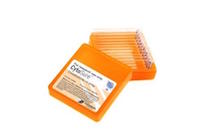Members Login

Channels
Special Offers & Promotions
Leading Experts Reveal how Exon-Focused Microarrays are Advancing Genetic Syndrome Research
OGT workshop at ESHG highlighted the impact of exon-level CNV analysis on accurate detection of genetic disorders
 Oxford Gene Technology (OGT), The Molecular Genetics Company, held an exclusive workshop exploring the power of exon-focused microarrays in enhancing genetic syndrome research at the recent European Human Genetics Conference (ESHG). Three expert clinical researchers from across the globe shared their knowledge of enhanced CNV detection with OGT’s CytoSure™ Constitutional v3 array, helping viewers understand how to implement the next generation of microarray into their laboratories. A validation programme from one of the speakers is also available as an application note.
Oxford Gene Technology (OGT), The Molecular Genetics Company, held an exclusive workshop exploring the power of exon-focused microarrays in enhancing genetic syndrome research at the recent European Human Genetics Conference (ESHG). Three expert clinical researchers from across the globe shared their knowledge of enhanced CNV detection with OGT’s CytoSure™ Constitutional v3 array, helping viewers understand how to implement the next generation of microarray into their laboratories. A validation programme from one of the speakers is also available as an application note.
The most up-to-date array platform for CNV detection currently available, OGT’s CytoSure Constitutional v3 array, targets all relevant genes and regions from ClinGen*, the Clinical Genome Resource, and the Deciphering Developmental Disorders (DDD) project. With up to 502 of the most disease-relevant genes targeted with high probe density, the array provides single-exon-level resolution. Enabling the detection of single-exon aberrations has proved valuable in many laboratories, including the West Midlands Regional Genetic Laboratory (Birmingham, UK). In his talk at ESHG, consultant clinical scientist Dominic McMullan, described the implementation of the CytoSure Constitutional v3 array in the NHS laboratory, and how it facilitated cost-effective, evidence-based analysis of large populations. He commented: “Our decision to switch to OGT over alternative platforms was based largely on the quality of the evidence base behind the array design, allowing for a very comprehensive analysis of exons, genes and regions key in postnatal and prenatal applications. Following a rigorous validation, we found this platform out-performed all others.”
Guiding viewers through the validation process in more detail, Dr Kris Van Den Bogaert from UZ Leuven (Belgium) discussed evaluation of the CytoSure Constitutional v3 arrays in prenatal and postnatal research. Prospective validation compared key quality metrics between two platforms, while retrospective validation analysed concordance with MLPA-confirmed aberrations. From this thorough validation, the new platform was found to increase coverage for clinically-relevant regions. The data is available to view in a free application note: “Adoption of the CytoSure Constitutional v3 microarray for increased detection of disease-relevant variants”.
In light of emerging genomic technologies, the latest CNV detection capabilities of the array remains a key part of the clinical genetics research framework, as explained by Professor Madhuri Hegde from Emory University School of Medicine (Georgia, USA). In this talk, she expanded on her work with OGT combining NGS, microarrays — including OGT’s CytoSure Disease-Focused Research arrays — and an all-inclusive genomic data interpretation platform for comprehensive analysis of genetic disorders. Product Manager at OGT, Anthony Allen, commented: “We’ve been witnessing an increasing trend towards the microarray and NGS being viewed as complementary rather than competing techniques. Professor Hegde’s talk reinforced this concept, and each of our guest speakers provided valuable insights into the ways researchers can implement exon-level CNV detection for more accurate genetic disorder identification.”
more about oxford gene technology
more news from oxford gene technology
Media Partners


